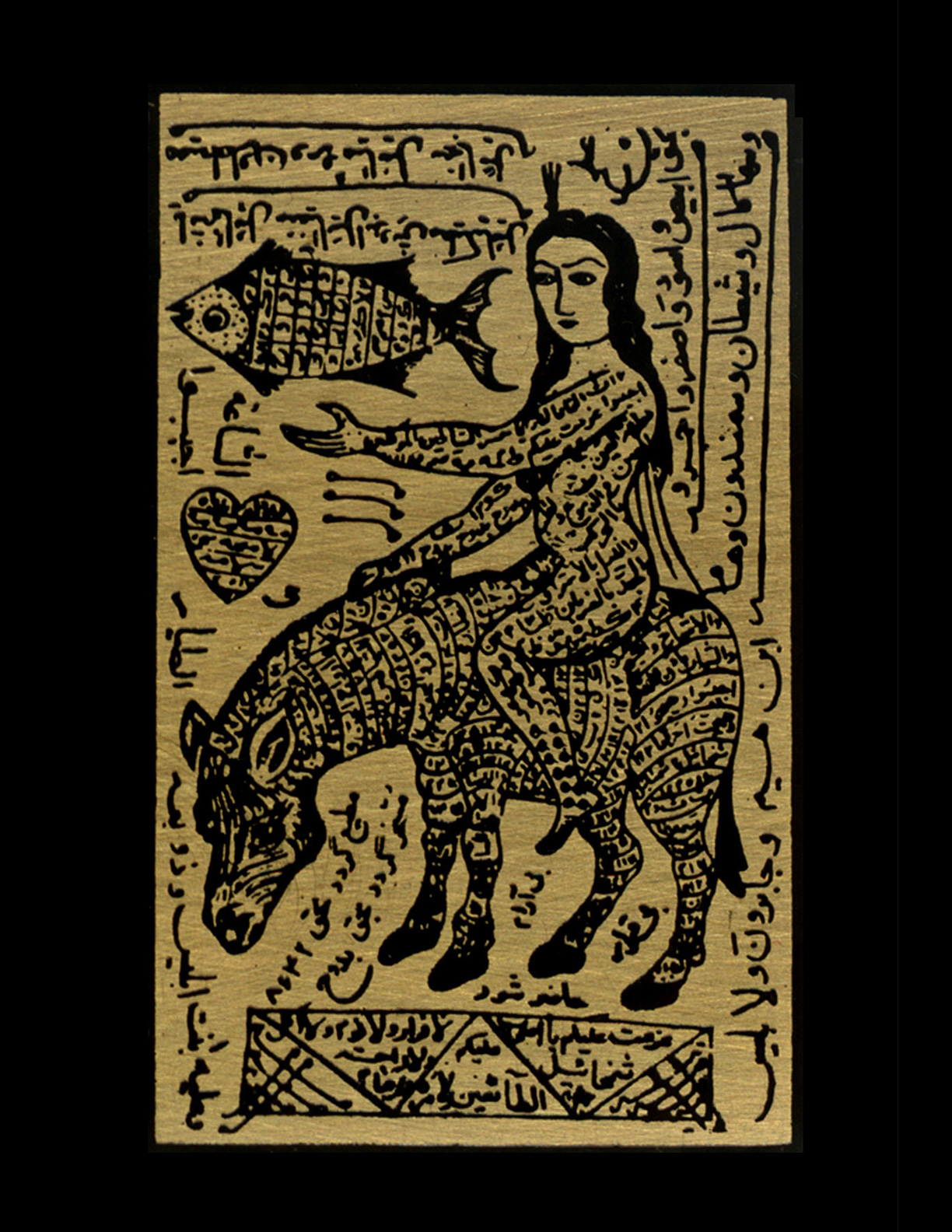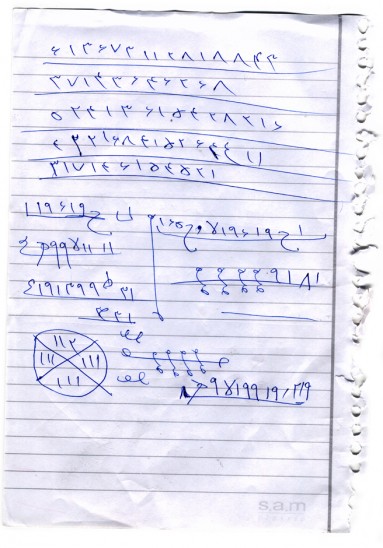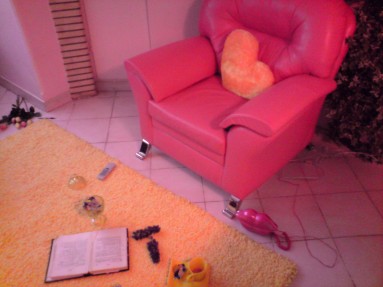Aspiring for middle-class life in Tehran can become an occult pursuit
In November 2008, I received a lesson in witchcraft. At a hole-in-the-wall café in Ariashahr, a young and populous district in western Tehran, my tutor, a 24-year-old woman named Mersedeh, sat with me at a table near the window, not far from two men smoking and playing backgammon. I peered over the pricey menu while she lit a candle and told me mournfully of her breakup with her boyfriend, a former national footballer and aspiring pop star. Then she edged her chair closer to mine, leaned forward with a pen in her hand, and we resumed discussing the symbols of Islamic talismanic magic.
This was my second time meeting Mersedeh there in as many months. Café management had changed, but she still liked to meet her customers there to read their coffee grounds, interpret their tarot cards, and perhaps schedule an appointment at her suite for further work. After she made a remark about the proper place of the bismillah (the Muslim incantation, “In the Name of God”) on magic squares, I asked if she had written any new spells to win back her boyfriend. Last time, we had written one together on a piece of paper torn out of my field notebook, setting it aflame inside the bathroom of her suite. She said she had not tried anything new, but she had teased the ex-beau about the possibility: A few days earlier, she had sent him a text message claiming she was digging around in the graveyard of a local saint’s shrine, about to unearth some locks she had buried to “bind” him. Then she texted him again to say she could not find them.
Over the next hour of our lesson, Mersedeh explained, among other things, the numerological procedure for determining compatibility between two lovers, the effect of ingested prayers on dogs, and some historical accounts drawn from a Persian translation of Kurt Seligman’s 1948 The History of Magic. Interspersed between the teachings were anecdotes of her own magical practice and reflections on her development as a fortune-teller and witch. As an anthropologist researching Iranians’ encounters with the supernatural, I was especially interested in these. She told me of her business advice and relationship counseling, of love magic and break-up magic, and of training to control jinn and ordering hits on adversaries. More than anything, she told me of her strategies—both magical and ordinary—for winning the hearts of wealthy men and for acquiring expensive cars.
Then, as if struck by an epiphany, Mersedeh turned to me with an amused grin: “You know what? You and I are a witchcraft couple. If we have a son together, he will need eyeglasses like you, and he’ll have my kind of hair. He will be Harry Potter!”
***
As a conversation topic, witchcraft can elicit all sorts of reactions in Iran: incredulity, fascination, humor, dread, ridicule, curiosity, indignation, and a full gamut of metaphysical, psychological, and sociological explanations. For public intellectuals worried about a resurgence of superstition, witchcraft has been explicable in terms of everything from the failure of modernization to ignorant attempts at assuaging economic anxieties and social uncertainties, to governmental indoctrination, to foreign schemes for corrupting public piety. More often than not, these accounts are gendered, identifying “gullible women and girls” as the hapless victims of charlatans, sexual predators, and drug dealers who sell them chimerical dreams for the price of their wealth, health, and chastity. Rare is the analysis that places modern witchcraft in the context of individualistic aspiration, set against more than two decades of economic privatization and the increasing valorization of personal responsibility and agency.
In the course of my research, I found this issue of individual aspiration—often barely concealed economic ambition—to be fundamental to understanding the allure that witchcraft commands among some members of the middle classes. The centuries-old storehouse of Islamic occult science and folk practices of healing and magic now furnish techniques, modulated by pop-psychology seminars, self-help literature, and a heavy dose of New Age spirituality, for the attainment of consumerist desires and dreams of social mobility.
***
Mersedeh was the youngest, most educated, and most self-consciously stylish of the occult specialists I met in Iran. Before I got to know her, I was used to meeting middle-aged and elderly men who operated out of cluttered, ramshackle quarters on the city’s fringes. One of these older men, a so-called Arab-Pakistani from a notorious family of prayer writers and exorcists, looked every bit a worn-out opium addict—or, I preferred to imagine, a defeated Saruman after the fall of Isengard: hair dirty and disheveled, cheeks hollowed, jaws missing a few rotted teeth. The old wizard’s house was rundown and dirty, its only memorable feature a larger-than-life portrait of himself that he kept in his small audience chamber, as if to double his menacing presence.
By contrast, Mersedeh worked out of a gleaming suite decorated in bright and garish pinks and yellows: a heart-shaped pillow here, a lip-shaped telephone there. (“I have a strange taste, don’t I?” she asked me playfully.) Her state-of-the-art stereo system pulsated with the soulful nostalgia of Lady Hayedeh, a prerevolutionary diva. She kept a bamboo plant and a bowl full of miniature Singapore turtles on a bed of yellow pebbles. She cleaned the tiny reptiles every day, she assured me, with water and antifungal medicine applied with an eyedropper.
Mersedeh’s appearance was also strikingly different from anyone else I had encountered in her line of work. She was of medium height, with a round face and large brown eyes accentuated by a heavy layer of mascara and smoky eye shadow that extended to her temples. She wore light-pink lip gloss, orange blush, and red nail polish. Her hair was cut short, dyed a light shade of brown, and hairsprayed straight. The two times I met her in public, she had draped a thin, black shawl over her head, its ends hanging loosely down the sides of her face and over her chest. Her manteau, also black, looked a size too small, most likely a deliberate choice to show off her figure. When I met her at her suite for our first lesson, she was wearing the same amount of makeup but far fewer articles of clothing, settling for a low-cut tank top and very short denim shorts.
Mersedeh had told me that her decorative choices in her suite were deliberately “strange”: She wanted to emphasize a chic modern style but was not afraid to express a sense of youthful mischief and—this is my interpretation—sexual energy. This “strangeness,” as Mersedeh explained, was crucial in creating an air of charisma around her persona as a witch, much in the same way that the Arab-Pakistani exorcist’s harrowing features and dilapidated quarters would have helped convince clients that he knew what he was doing. To me, Mersedeh’s carefully-crafted personal appearance was likewise intended to signal a propensity for sexual-cum-metaphysical mischief that had the power to unleash terrible forces.
If this charisma could instill confidence in her customers, it could also fill them with dread. My research assistant, a male sociology student, told me that he felt the sting of Mersedeh’s “Satanic” eyes and that I should avoid seeing her alone, lest she create problems for me later on (and here he was ambiguous as to whether these “problems” would be caused by witchcraft or something like a sexual scandal, although his tone hinted at both). But Mersedeh’s appearance may not have been threatening merely because she was a woman with too much makeup. It was threatening because she was a lower-middle class woman with too much ambition.
Understood in this way, Mersedeh was a true denizen of Ariashahr, a largely residential district where middle-class migrants from other cities and southern neighborhoods of Tehran have settled over the past two decades as business opportunities expanded in the capital. A young uptown Tehrani may have judged her, based solely on appearance, to be a daaf-e ariashahri, an “Ariashahri chick.” Such “chicks” (and their male counterparts) are distinguished negatively from other youth by their overzealous—and therefore unsuccessful—attempts to meet the ever-shifting standards of style upheld and judged by Tehran’s hippest denizens. Too exhaustive a makeup application, too exaggerated a coiffure, two short (or bright or tight or transparent) a manteau—the “too much” here measured against the hip “just right”—are enough to invite critical scrutiny. This is fundamentally an expression of class privilege, or, in Pierre Bourdieu’s terms, an articulation of a gap in cultural capital. The one who “tries too hard,” as the Ariashahri chick invariably does, aims to climb the social ladder by accumulating cultural points along with other advantages—like moving to Tehran and starting a business—but fails to fully claim these points because she lacks the virtuosity of the Tehrani natives who embody their capital through extended socialization.
Living in Ariashahr, like applying too much makeup, may signify to the Ariashahri that she has “arrived” in Tehran, but to the uptown Tehrani native they are telltale signs of cultural inferiority worthy of snobbish dismissal. Mix in the intrepidness of a figure like Mersedeh the witch, however, and the uptown Tehrani may no longer sneer at the Ariashahri but tremble.
***
For Mersedeh, witchcraft was a vehicle for arriving at multiple destinations. With her parents living 20 miles west of the capital in Karaj, it was the means for financial independence in Tehran. It was a tool for seducing and maintaining desirable high-status men. It secured some prestige for her among friends and strangers alike as a problem solver and healer. It shielded her from the ill will of others by functioning as a warning sign. It even seemed to have brought her small bits of cultural capital in the form of knowledge and learning; for example, she told me that she had learned to read and understand the Koran not in public school (where she horsed around during Koran class) but through her education in witchcraft.
If witchcraft was all these things for Mersedeh, its condition of possibility lay in particular economic circumstances and a specific cultural and intellectual milieu. By 2008, Iranian society had undergone almost 20 years of haphazard economic liberalization, as well as progressive commercialization of various aspects of urban life, all initiated at the end of the 1980–88 war with Iraq. Mirroring the state’s attempts to strengthen private enterprise was the emerging “success” industry, which marketed mostly translated self-help and prosperity literature and seminars. Some of the most popular authors and motivational speakers were those who blended business and financial advice with a spiritual cum mystical ethos inspired by American speakers like Wayne Dyer, whose translated works are widely available.
The spirit of this moment was most brilliantly captured by Rhonda Byrne’s 2006 film The Secret and the series of books that it spawned, all of which found an eager audience among an Iranian middle class looking to tie together their desire for business success and consumer goods with their more spiritual yearnings. In Mersedeh’s apt if idiosyncratic formulation, The Secret was the foundation of prayer and witchcraft: “To explain it in very simple terms,” she said, “all the world around us is energy. Witchcraft and prayer writing and talismans are all energies. Even the body consists of compressed energy.” The energies that humans emit can be either positive or negative. And they remain in the world forever.
Every prayer, every wish and desire, every feeling, has its own frequency. “Say you want a Mercedes Elegance. There is a wavelength to your desire that wells up from within you. This is what the cosmos hears.” These are frequencies that already exist in the cosmos. Yet by making a wish, expressing a desire, feeling a certain way, we make the relevant frequencies resonate. When a certain prayer has resonated frequently enough through a specific channel—a word, a written sign, or an image like those talismanic symbols we had been discussing—it becomes all the more likely for that particular channel to materialize the specific prayer or wish. Sometimes this is a matter of what Byrne calls “creative visualization.” Mersedeh offered, “If you stare at a picture of a Mercedes Elegance long enough and imagine that it belongs to you, you emit the proper kinds of frequencies to the cosmos, and the cosmos will eventually give you the car.”
Repetition is crucial for the efficacy of such images and symbols. “Whenever something is repeated,” she went on, “its power increases in the cosmos. It’s like if, from afar, I keep saying ‘Alireza I love you, I do I do I do.’ This eventually affects your heart. Now, the more I say this, the more it infiltrates your unconscious.”
Mersedeh knows a thing or two about the unconscious: At the time of our interview, she was a master’s student in clinical psychology at Azad University. When she was not writing spells, reading tarot cards, or performing Reiki, she sometimes counseled families and young people at a community center nearby. The two lines of work shared a concern with helping people succeed and heal, but also, for Mersedeh, an emphasis on generating confidence to serve their efficacy—except that prayer writing was more successful. She illustrated her argument with an example:
On any given day a girl might come to counseling and say: “I want to slash my wrist, I feel awful.” This person’s mind is a collection of negative frequencies and thoughts. Now I tell her, look, don’t think negatively, your life will be fixed up, go do this or that. I offer her some strategies. But these words won’t change her beliefs. She’ll try to think as I tell her, but it won’t work.
Now for the same person, I do counseling and I also do prayer writing. But my prayer writing is much more successful than my counseling. Because even though the girl comes in and gets counseling, she doesn’t come to believe. From her point of view, I’ve shown her a strategy. But sometimes I’ll say, I know how to do prayers, and I’m telling you: Go off, and take this prayer with you, and do this or that to it for 40 days, and this issue of yours will be sorted out. The person leaves, and holding fast to the belief that it will work, she discards all those negative thoughts, and all those negative frequencies go away and her soul is purified. And during this time, either her lover returns to her, or her issue is sorted out, or she gets some money, or some new opportunity presents itself to her and her life changes for the better.
The self-confidence that came with faith in the magical power of creative visualization had, perhaps unexpectedly, strengthened Mersedeh’s avowedly feminist perspectives on love and work. Love often got in the way of work, she told me, and it jeopardized women’s independence:
One time a client asked me, why don’t you try to gain the financial support of a man? I said, you’re right! Let me try to do that. I have the looks, so why don’t I get a man to support me, rather than supporting myself all the time. So I got a boyfriend. I looked for a super rich person. And it doesn’t take me that long to find someone. I wanted to find someone with a Mercedes Elegance. I asked some friends who worked in a car dealership to let me know if they ever had a young customer who wanted to buy an expensive, recent model Mercedes Elegance, so that I could get him. They did, and I got him. But I realized soon that the time I was devoting to talking to this guy on the phone, and going out with him so that he’d support me, I could have used that time to work myself. Why shouldn’t I do that?
Living in Ariashahr, wearing a lot of make-up, and practicing witchcraft were three things that had helped make Mersedeh a Tehrani. But all were signs to uptown Tehrani “natives” that she is not up to the capital’s lofty standards. Although the uptown Tehrani might—with fear and trembling—visit a practicing witch like Mersedeh in secret to help solve a problem of love, health, or wealth, she would prefer to keep witchcraft at arm’s length, something better appreciated for its aesthetic value rather than its metaphysical efficacy: as literature (the magical realism of Gabriel García Márquez and Paulo Coelho) or as jewelry (talismanic motifs have recently come into vogue).
Mersedeh, I sensed, was painfully aware of this difference. She went to great lengths to distinguish the “physics, chemistry, psychology, and metaphysics” of witchcraft from the superstitions of illiterates and junkies like the aforementioned Arab-Pakistani. Her zeal for witchcraft was, in her own estimation, a matter of youthful mischief. It had served her well in business, in love, and in her own peculiar spiritual journey. Still, it could take her only so far. At this point in her life, nothing could go further, as she starkly put it, than her own confident voice and hard currency in her pocket. “Maybe witchcraft belonged to a time,” she told me, “when, if someone wouldn’t come to me, I would have had to resort to it to bring him toward me somehow. But right now there are telephones. For every person there’s a point, a word, a need, or a weak spot that you can use to tame them, calm them. If you put your finger on that and use it to get to them, it’s the best witchcraft. When I know that everything is only one step away from my grasp, and that we ourselves are the greatest power, why do I need to waste my time with this sort of thing?”



